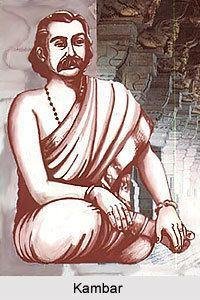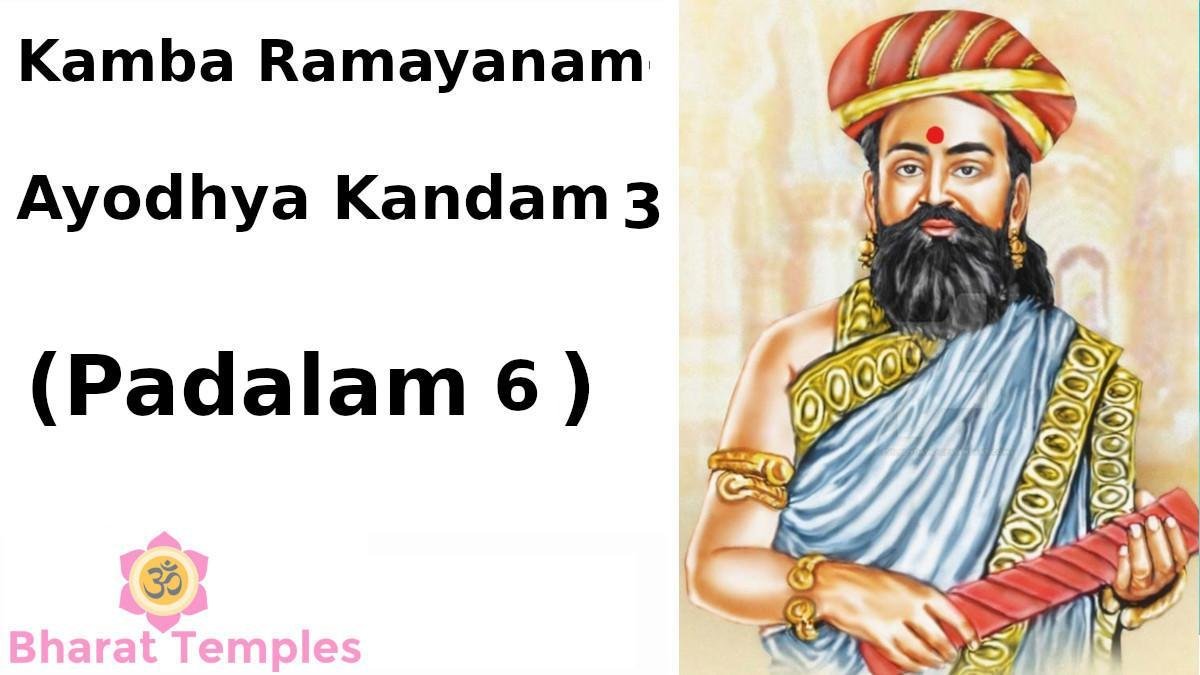By Kambar (Kavichakravarthy Kamban)
Translated in English by P. R Ramachander
Kamba Ramayanam-Ayodhya Kandam 3 (Padalam 6)
6.Gangai PadalamChapter on Ganges
(Rama , Sita and Lakshmana reach river Ganges. Saints who were living there and received them. In Valmiki Ramayanam Sumanthra is with them till they reach the river Ganges and then only returns.)
1926. Rama whose comparison to Kajal or emerald or the tumultuous sea , Or The rain clouds would not be , alas , really adequate And whose body which had the destruction less prettiness ,With the light of the sun falling on him and reflecting blue colour,Went along with her whose “waist “is a lie and his brother.
1927. She who had matchless hair which was like black sand lying near to each other ,She who had sweet speech which is comparable only with nectar churned out from sea,She who had pure qualities like complete penance and had a matchless sky like waist,And Rama who had the gait of a strong bull were going on their path,Like the male swan with very great pride and the female swan with simplicity.
1928. Sita who had pretty eyes which defeated the five arrows of god of love,As well as the sharp arrows of Lord Rama , as something inconsequentialAnd which were in a position to win victory over cruel poisons , saw that ,The pretty as well as proud bees with their nature of setting down on hair,Were preferring to settle down on the flower like feet of Rama .Rather than the lotus flowers which had bloomed all around.
1929-1930. With Sita who had hair scented with perfume powders and pollen grains ,And had crescent of moon shaped forehead and Rama who had lips,Which added redness to corals walked like cloud coming with lightning,Like the pretty male elephant wearing ornaments coming with female elephants . Rama saw the crowd of blue lily flowers being thrown from the field Which wasSimilar to the eyes of Sita with a voice similar to that of a parrot , which wasLike the nectar like music raising from the flute with holes which can be enjoyed by the ears.Like the music which comes out from Yaazh which had tightly tied strings,Like the pure quality honey , with well matured bar of sugar syrup.
1931. That Sita with her breasts similar to two golden pots over which,The newly formed flower buds have been kept and like the very proud , Tusks of the Male Elephant and hairs like the cloud of rainy season,Seeing the presses for extracting juice out of sugar cane here and there ,Went on playing with Rama who had mountain like shoulders.
1932. They both saw ghats made by row of pearls created by several clams ,Gardens where swans were sleeping , sand heaps with conches lying about ,Gardens with floors showered with dropping flowers ,And Rivers which were pushing good dust of gold and became very happy.
1933. Old buffaloes after eating awns of paddy were standing with rice milk,Flowing from the corner of their mouth and were jumping with their legs in to the water ways,The Chel and Kayal fishes were jumping in the river with bees flying from honey dripping flowers,And in the river water that was rushing , the red legged she swans who were similar to ladiesWere dipping in the river and seeing all this they crossed the long Kosala kingdom.
1934. Those three who were wearing ornaments shining like sun ,After crossing that prosperous country which had wealth giving fields Reached river Ganges which was always surrounded ,By sages who were greatly learned in Vedas and which had broad waves.
1935. All the sages who were living on the shores of the divine river Ganges ,Became overjoyed thinking that they have already got the waves to salvation,And with great anxiety came to see Rama who had graceful sages.
1936. The sweet taste of the enjoyment by five senses of ladies,Which cannot be easily understood by others and also the God,Who can be understood by Vedas of the musical form, Were seen by them and their mind became very happy.
1937. Those sages who held the staff made of Bamboo,Ate by their eyes the lustrous one with lotus eye ,Like the nectar churned of the sweet ocean of milk,Welcomed him , praised him sang about him and danced.
1938. Like the parents who daily think of their children,Who have gone away from home and were searching for them,Becoming extremely joyous , when they come back at last,The sages received them and took them to hall of sacrifice .
1939. Those sages bathed them with the tears flowing from their eyes,Made them wear the garland of the sweet words they were speaking ,And offered them the nectar called love for them eat ,And took away all the tiredness they felt by walking long distance .
1940. They then brought very clean vegetables and fruits from forest,And looking at Rama told “oh Rama who is better than all people,Please take bath in the great waters of Ganges, grow fire,Complete your rituals and then eat this food.
1941. Rama held Sita who was like a lamp for the ladies by his red hands ,Took bath in Ganges , Which was made by the washing of his own feet,By Lord Brahma using the water in the water pot ,When he was trying to remove the sorrow of devas.
1942. The Ganges which forever lives, saluted Rama with her hand and told,“all those in this earth wash away their sins which can never be ever destroyed,Through me and today , I also have washed away my sins through you,Who gave me and so I am completely saved,” she said.
1943. Rama who had long hands like the trunk of elephant with cruel eyes.Who has the matted tuft through which the white Ganga flows,Took bath in her when Sita who was great in her virtue was seeing him,And looked like Lord Shiva who wears on his head the moon’s crescent.
1944. Due the waves of Ganges which lashes Rama who was taking bath in her,Looked like he was taking rest with Goddess Lakshmi with thin waist and sits on lotus, On the silver coloured ocean of milk on the Adhi Sesha once upon a time.
1945. Sita who had feet as soft as the red cotton with the Vanchi creeper,Getting defeated by her very thin waist , with swan getting defeated by her walk ,Played with Kayal fishes under water , hiding her lotus like soft feet.
1946. That Ganges though she had been living in the tough matted hair,Of the god of gods for a very long time did not have the perfume of.The garland of erukku flowers and that of Ixora flowers , from head of lord ShivaAnd had the scent of fresh flowers and that of musk from the pretty hair of Sita.
1947. Due to the white foam rising above the river ,The lady Mandakini appeared to have white hair ,And considering the lack of female company to Sita,Acted like mother maid mother and extended her arm like waves and waved.
1948. The long black hairs of Sita which looked like crowd of clouds ,Went down and was whirling with the tide there and looked like,The black waters of Yamuna which mixes with river Ganges,And rises above as the whorls which were moving.
1949. When in the Ganges where whirls are made and rise up from there,And in its white water in which fishes which were like her eyes were jumping,Sita was going down and coming up and appeared like ,Goddess Lakshmi dipping in the water of the ocean of milk.
1950. Due to the red divine feet of Rama touching it ,Ganges which removes the cruel sins of all people,Was able to touch the entire body of the holy Rama,And will all the world which dips in her, would ever go to hell?
1951. In the ghats of Ganges after taking bath in her scented water ,Rama reached the hermitage of those Vedic saints ,He saluted the god principle which can only be realized by very wise people ,And after saluting the fire of Yagna became ,Dear to the wise sages and a suitable guest for them.
1952. When the devas with lot of difficulty brought the nectar ,He made them to eat it by saying , “You please eat it “,Without him eating it , but he ate the very soft leafy vegetable,For the people whose mind is good , there is nothing ,Good or bad in the service done by others.
Download PDF (Kamba Ramayanam: Ayodhya Kandam 3 (Padalam 6)
Kamba Ramayanam: Ayodhya Kandam 3 (Padalam 6) – Kamba Ramayanam: Ayodhya Kandam 3 (Padalam 6)
Download PDF: Kamba Ramayanam: Ayodhya Kandam 3 (Padalam 6) in English PDF
Read More :
Kamba Ramayanam: Ayodhya Kandam 3 (Padalam 5)
Kamba Ramayanam: Ayodhya Kandam 3 (Padalam 6)
Kamba Ramayanam: Ayodhya Kandam 3 (Padalam 7)
Kamba Ramayanam: Ayodhya Kandam 3 (Padalam 8)
Kamba Ramayanam: Ayodhya Kandam 3 (Padalam 9)
About Kavichakravarthy Kamban

Historians place him in the 9th century CE, But surely Kamban belongs to the third great wave of Tamizh literature that started with the Sangam period (dated before the Common Era), followed by the widespread impact of Bhakti literature of the Alwars (vaishnavite saints) & Nayanamars (shaivaite saints). Kamban Authored Ramanaya in Tamil…Known as Kamba Ramayanam..
Kambar has been the milestone for the Tamil scholars that none had reached. He was also known as “Kamba Naatazhvar” at his time. Many Tamil authors from the modern world have written the books on the poet Kamban.
FAQs
Kambar or Kavichakravarthy Kamban (1180–1250) was a medieval Tamil poet and the author of the Ramavataram, popularly known as Kambaramayanam, the Tamil version of the epic Ramayana.
Valmiki Ramayana and Kamba Ramayanam are two versions of Ramayana written in the Sanskrit and Tamil languages respectively. … Kamba Ramayanam is originally called as Ramavataram. Although Valmiki Ramayana is the original version of the story of Rama, Kamba Ramayana is believed to be based on the work by Valmiki.
The Kamba Ramayanam, is a Tamil epic that was written by the Tamil poet Kambar during the 12th century. Based on Valmiki’s Ramayana (which is in Sanskrit), the story describes the life of King Rama of Ayodhya.
The book is divided into six chapters, called Kandam in Tamil. The Kandams are further divided into 123 sections called Padalam (படலம்) in Tamil. These 123 sections contain approximately 12,000 verses of the epic.

